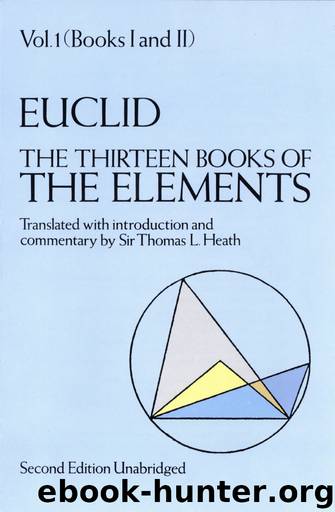The Thirteen Books of the Elements, Volume 1 by Euclid

Author:Euclid
Language: eng
Format: epub
Publisher: Dover Publications
Published: 1956-05-13T04:00:00+00:00
But the angle EBA is right.
Therefore the angles EBA, FBA are equal: which is impossible.
Zeno objected to this, says Proclus, because it assumed the later proposition I. 11 for its proof. Posidonius said that there was no trace of such a proof to be found in the text-books of Elements, and that it was only invented by Zeno for the purpose of slandering contemporary geometers. Posidonius maintains further that even this proof has something to be said for it. There must be some straight line at right angles to each of the two straight lines AC, AD (the very definition of right angles assumes this): “suppose then it happens to be the straight line we have set up.” Here then we have an ancient instance of a defence of hypothetical construction, but in such apologetic terms (“it is possible to say something even for this proof”) that we may conclude that in general it would not have been accepted by geometers of that time as a legitimate means of proving a proposition.
Todhunter proposed to deduce that two straight lines cannot have a common segment from I. 13. But this will not serve either, since, as before mentioned, the assumption is really required for I. 4.
It is best to make it a postulate.
POSTULATE 3.
.
To describe a circle with any centre and distance.
In this case Euclid’s text has the passive of the verb: “a circle can be drawn”; Proclus however has the active () as Euclid has in the first two Postulates.
Distance, . This word, meaning “distance” quite generally (cf. Arist. Metaph. 1055 a 9 “it is between extremities that distance is greatest,” ibid. 1056 a 36 “things which have something between them, that is, a certain distance”), and also “distance” in the sense of “dimension” (as in “space has three dimensions, length, breadth and depth,” Arist. Physics IV. 1, 209 a 4), was the regular word used for describing a circle with a certain radius, the idea being that each point of the circumference was at that distance from the centre (cf. Arist Meteorologica III. 5, 376 b 8: “if a circle be drawn . . .with distance MII”). The Greeks had no word corresponding to radius: if they had to express it, they said “(straight lines) drawn from the centre” (), Eucl. III. Def. 1 and Prop. 26; Meteorologica II. 5, 362 b 1 has the full phrase .
Mr Frankland observes that it would be remarkable if, unlike Postulates 1 and 2, this Postulate implied merely what it says, that a circle can be drawn with any centre and distance. We may regard it, if we please, as helping to the complete delineation of the Space which Euclid’s geometry is to investigate formally. The Postulate has the effect of removing any restriction upon the size of the circle. It may (1) be indefinitely small, and this implies that space is continuous, not discrete, with an irreducible minimum distance between contiguous points in it. (2) The circle may be indefinitely large, which implies the fundamental hypothesis of infinitude of space.
Download
This site does not store any files on its server. We only index and link to content provided by other sites. Please contact the content providers to delete copyright contents if any and email us, we'll remove relevant links or contents immediately.
| Applied | Geometry & Topology |
| History | Infinity |
| Mathematical Analysis | Matrices |
| Number Systems | Popular & Elementary |
| Pure Mathematics | Reference |
| Research | Study & Teaching |
| Transformations | Trigonometry |
Modelling of Convective Heat and Mass Transfer in Rotating Flows by Igor V. Shevchuk(6349)
Weapons of Math Destruction by Cathy O'Neil(6077)
Factfulness: Ten Reasons We're Wrong About the World – and Why Things Are Better Than You Think by Hans Rosling(4618)
Descartes' Error by Antonio Damasio(3183)
A Mind For Numbers: How to Excel at Math and Science (Even If You Flunked Algebra) by Barbara Oakley(3179)
Factfulness_Ten Reasons We're Wrong About the World_and Why Things Are Better Than You Think by Hans Rosling(3158)
TCP IP by Todd Lammle(3095)
Applied Predictive Modeling by Max Kuhn & Kjell Johnson(2976)
Fooled by Randomness: The Hidden Role of Chance in Life and in the Markets by Nassim Nicholas Taleb(2964)
The Tyranny of Metrics by Jerry Z. Muller(2950)
The Book of Numbers by Peter Bentley(2872)
The Great Unknown by Marcus du Sautoy(2609)
Once Upon an Algorithm by Martin Erwig(2538)
Easy Algebra Step-by-Step by Sandra Luna McCune(2535)
Lady Luck by Kristen Ashley(2493)
Practical Guide To Principal Component Methods in R (Multivariate Analysis Book 2) by Alboukadel Kassambara(2444)
Police Exams Prep 2018-2019 by Kaplan Test Prep(2438)
All Things Reconsidered by Bill Thompson III(2325)
Linear Time-Invariant Systems, Behaviors and Modules by Ulrich Oberst & Martin Scheicher & Ingrid Scheicher(2301)
